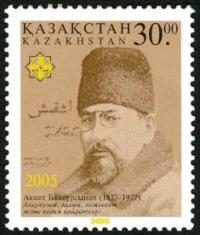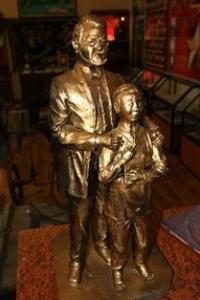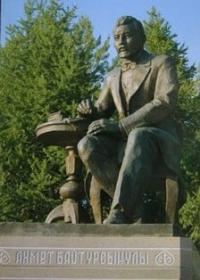You are here
Akhmet Baitursynov (1873 - 1938).



Observing excursion tour in Kazakhstan.
“In order to preserve our independence, we need to strive by all means and means to enlightenment and common culture, for this we must first of all engage in the development of literature in our native language. One should never forget that only those people who speak their own language and have their own literature have the right to claim an independent life.. ”.
Akhmet Baitursynov. Excerpt from the newspaper "Kazakh".
Guided walking tour in Kostanai region.
Akhmet Baitursynov is a poet, scientist, Turkologist, translator, teacher, publicist, public figure. At one time he became a victim of the injustice of Stalin's repressions, for more than half a century he did not deserve mention, his name did not occupy a worthy place in the history of Kazakhstan.
Only now, in the conditions of changes, when “white” spots in history are being removed, the names of such figures as Shakarim Kudaibergenov and Magzhan Zhumabaev, Zhusupbek Aymauytov, Myrzhakyp Dulatov and Akhmet Baitursynov have been returned to the people.
A. Baitursynov was born on January 18, 1873 in the Tosyn volost of the Turgai district, in a peasant family. He received his initial education in his native village, then studied at the Turgai Russian-Kazakh school (1886 - 1891), at the Orenburg teacher's seminary (1891 - 1895).
He began his pedagogical activity in 1895 as a teacher in aul then volost schools. In 1909, being the head of a two-year Russian-Kazakh school, in the city of Karkaralinsk he joined the opposition to the existing system, for which he was arrested and exiled to the city of Orenburg.
This period includes his scientific searches in the field of Kazakh linguistics and methods of teaching his native language. In subsequent years, he began to develop the principles of the reform of the Kazakh writing, develops scientific terminology to determine the categories of Kazakh grammar.
A. Baitursynov is the author of the first Kazakh primer. The new Kazakh alphabet, named in honor of the scientist Baitursyn, once served as a good model for all Turkic-speaking peoples during the reform of writing.
The author also wrote "A manual on the native language", "Presentation of the course of the Kazakh language", "Guide to the study of grammar", "Development of speech", various anthologies. These methodological works are still respected by scientists in the field of Kazakh linguistics and methods of teaching the Kazakh language.
A. Baitursynov began his creative activity as a fabulist. In his poems, he expressed the needs and aspirations of the Kazakh people, his dream of a bright future, denounced the hypocrisy of the bureaucratic apparatus, called for the light of knowledge and culture. In the works "Forty Fables" (1909), "Masa" (1911), "Komar" (1911), such human vices and shortcomings as idleness, laziness, vanity, ignorance are ridiculed.
In 1913 A. Baitursynov became the first editor of the Kazakh newspaper, created on the initiative of the Kazakh intelligentsia. The main thing in the newspaper's program was coverage of the problems of the development of the Kazakh language, culture, school education.
After the revolution of 1917, being a member of the Alash party, A. Baitursynov was elected a member of the Military Revolutionary Committee of the Kyrgyz (Kazakh) Territory, worked as the People's Commissar for Education of the Territory (1920 - 1921), Chairman of the Academic Center (1921 - 1922. g.), is a member of the scientific and methodological council of the People's Commissariat for Education.
In 1920 he joined the RCP (b), in 1921 - 1928 he worked at the Kazakh Institute of Public Education, where he gave lectures on the Kazakh language and literature, history and culture. In 1928-1929 A. Baitursynov was a professor at the Kazakh State University.
The graphic system created by him and named after him made it possible to quickly eliminate illiteracy, improve the written culture of the Kazakhs. In June 1929, during a creative trip to Kyzyl-Orda, A. Baitursynov was arrested.
He was charged with the fact that in 1926 at the congress of Turkologists in Baku, he met with foreign scientists, tried to establish contact with Mustafa Chokaev, allegedly so that he would help implement the plan of separating Kazakhstan from Russia.
In 1931 he was exiled to the Arkhangelsk region, from where he returned to Alma-Ata only three years later. And in 1937, when a new wave of repression broke out, he was arrested again. On December 8, 1938, Akhmat Baitursynov was shot as an "enemy of the people."
But time put everything in its place. In 1988, Akhmet Baitursynuly was rehabilitated. Scientist, educator Akhmet Baitursynov is with us again. In his books, in the fund named after him, in the names of streets, and most importantly, in his ideas, which are consonant with the problems of the day.
In Alma-Ata, at the corner of Baitursynov and Dzhambul streets, a house-museum of Akhmet Baitursynov was opened and a monument-bust to the educator was erected near it, in the village of Turgai, Dzhangeldinsky district, Kostanay region, a literary museum of Akhmet Bayatursynov and Myrzhakip Dulatov was opened.
Monuments were erected to him in Kostanai (2000), Shymkent (2004), streets in many cities of Kazakhstan were named after him; Kostanay State University was named after Baitursynov.
Authority:
http://www.tarih-begalinka.kz/ru/history/revolution/figures/zhangeldin/







